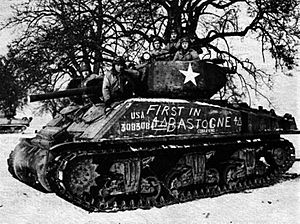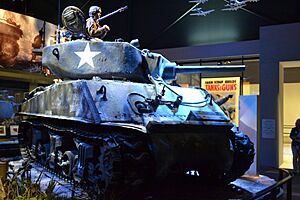Cobra King (tank) facts for kids
Quick facts for kids Cobra King |
|
|---|---|

Cobra King shortly after the Battle of Bastogne
|
|
| Type | M4 Sherman "Jumbo" |
| Place of origin | |
| Service history | |
| In service | 1944–March 27, 1945 |
| Wars | |
| Production history | |
| Designer | U.S. Army Ordnance Department |
| Designed | 1940 |
| Manufacturer | Fisher Tank Arsenal |
| Specifications | |
| Crew | 5 (commander, gunner, loader, driver, assistant driver/bow gunner) |
|
|
|
| Armor | 4.0 inches (100 mm) |
|
Main
armament |
75 mm gun M3 (90–104 rounds) |
| Engine | Ford GAA V8 gasoline engine 450 horsepower (340 kW) at 2,600 rpm |
| Transmission | Spicer manual synchromesh transmission, 5 forward and 1 reverse gears |
| Ground clearance | 17 inches (43 cm) |
| Maximum speed | 22 mph (35 km/h) |
Cobra King was a famous American M4 Sherman tank from World War II. It was a special "Jumbo" version, meaning it had extra thick armor. This made it slower than regular Sherman tanks but much tougher against enemy attacks.
Cobra King played a key role during the Battle of the Bulge in December 1944. German forces had surrounded American soldiers in the town of Bastogne, Belgium. Cobra King was the very first tank to break through the German lines. It reached the trapped American 101st Airborne Division, bringing them much-needed relief.
Contents
Cobra King's War Journey
Cobra King first saw action in 1944. It was damaged during fighting in France in November 1944. Luckily, it was repaired and sent back to the front lines.
Joining General Patton's Army
In late 1944, Cobra King joined Company C of the 37th Armor Regiment. This regiment was part of the American 4th Armored Division. This division was the main attacking force for General Patton's Third Army. They were racing to help the soldiers trapped in Bastogne.
The 37th Tank Battalion was led by Creighton Abrams. He later became a famous general himself. Cobra King's crew included Lieutenant Charles Boggess as commander. The rest of the crew were Hubert S. Smith (driver), Harold Hafner (co-driver), Milton Jafet (gunner), and James G. Murphy (loader).
Breaking the Siege of Bastogne
On December 26, 1944, Cobra King led its company into heavy fighting. They battled their way through the village of Assenois. At 4:50 PM, Cobra King finally met up with American engineers. This moment officially broke the German encirclement around Bastogne. It took a few more days to fully secure supply routes, but the siege was over.
[T]he tank crew spotted some soldiers in the distance who through binoculars looked like Americans. But the tankers were wary because infiltrating German troops were said to be dressed as Americans. Finally, an American soldier strode to the tank, stuck his hand out to Boggess, and said "Glad to see you".
After the Battle of the Bulge, Cobra King was upgraded with a more powerful 76 mm gun. It continued fighting as the war moved into Germany. Over time, the words "First In Bastogne" painted on its side faded away. The tank also got a new crew. Because of this, its special history was largely forgotten for a while.
Cobra King's Final Battle
Cobra King was later part of a mission called Task Force Baum. This mission aimed to free prisoners from a German camp. During this mission, all the tanks involved were destroyed. On March 27, 1945, Cobra King was hit by an enemy weapon called a Panzerfaust. The shot went through its armor and started a fire inside. The crew had to leave the tank, but thankfully, no one was killed.
After the War: A Tank's Journey Home
After World War II ended, the damaged Cobra King was found on the battlefield. It was then used as a display tank, or "gate guard," at different military bases in Germany. It stood at McKee Barracks (1957-1967), Ferris Barracks (1967-1993), and Rose Barracks (1993-2008).
Rediscovering a Hero
For many years, Cobra King's true identity was unknown. But an Army chaplain named Keith Goode started to suspect that the old, rusty tank at Rose Barracks was the famous Cobra King. In 2008, Army historians confirmed it!
Cobra King was built at the Fisher Tank Arsenal in Flint, Michigan. Only 254 "Jumbo" tanks were ever made. Each one had a unique serial number and Army registration number. By matching these numbers, historians were able to confirm that this was indeed Cobra King.
Restoration and New Home
In July 2009, Cobra King was shipped from Germany to the Patton Museum in Fort Knox, Kentucky. There, it began a long restoration process. Workers had to find original parts, like a Ford V-8 engine and the correct tracks. The outside of the tank was carefully restored. The inside, which had been damaged by fire, was cleaned but not fully rebuilt. They even found dozens of spent bullet casings inside!
On August 3, 2017, Cobra King was moved to its final home. It is now on display at the new National Museum of the United States Army at Fort Belvoir, Virginia. This allows visitors to see and learn about this important piece of history.


